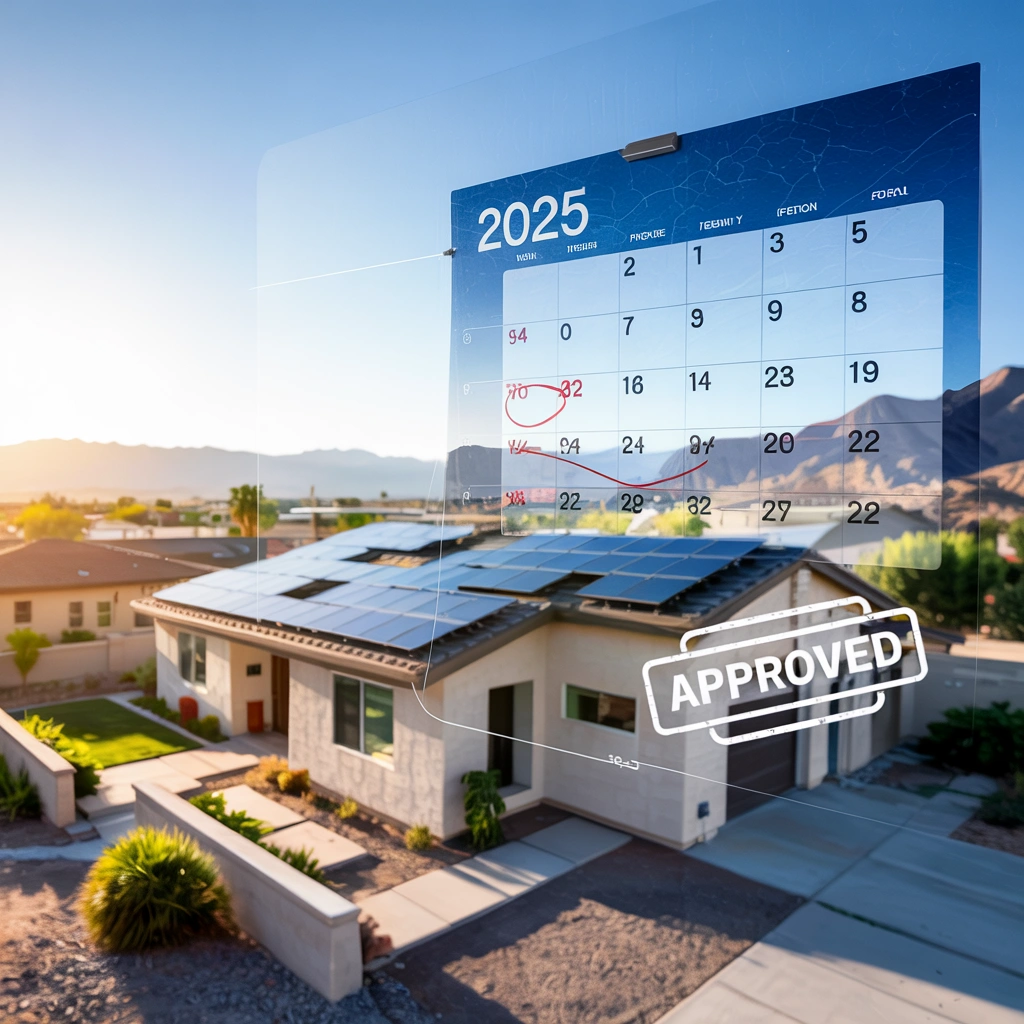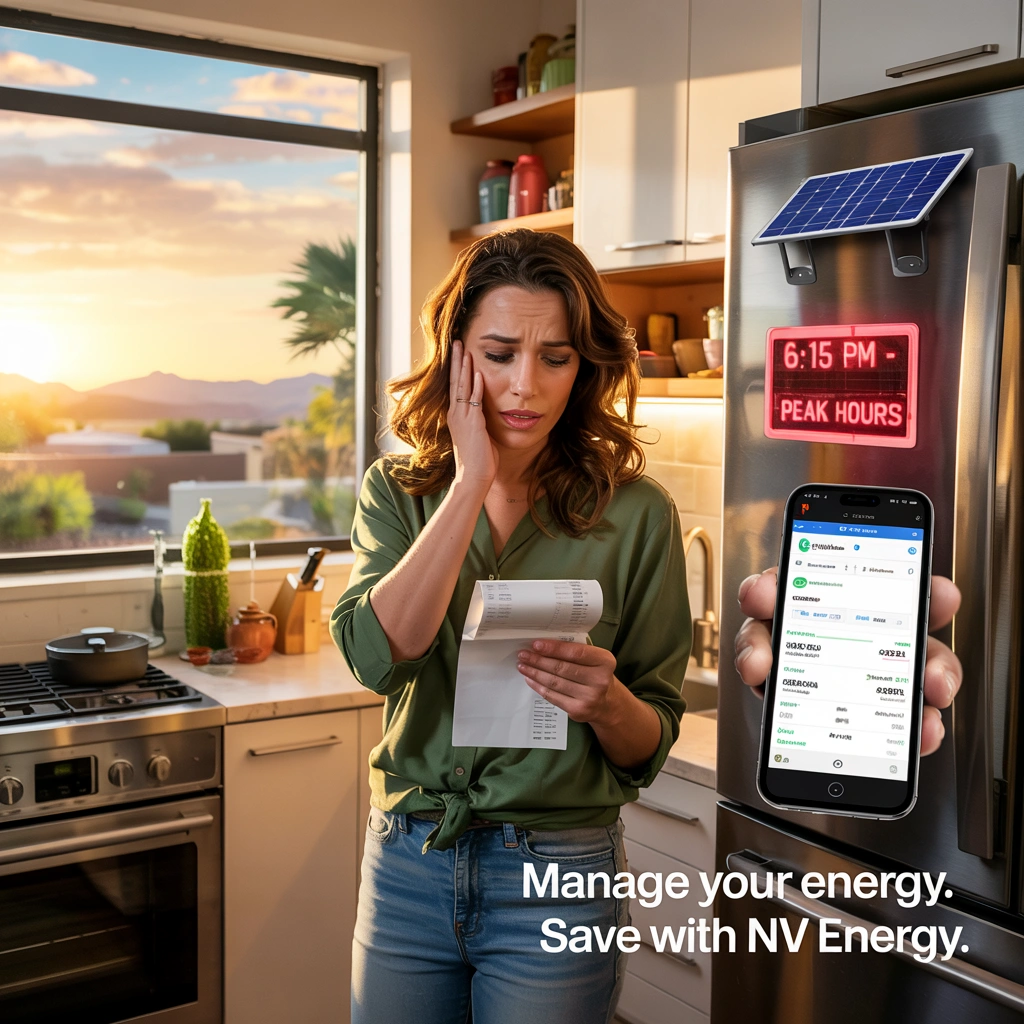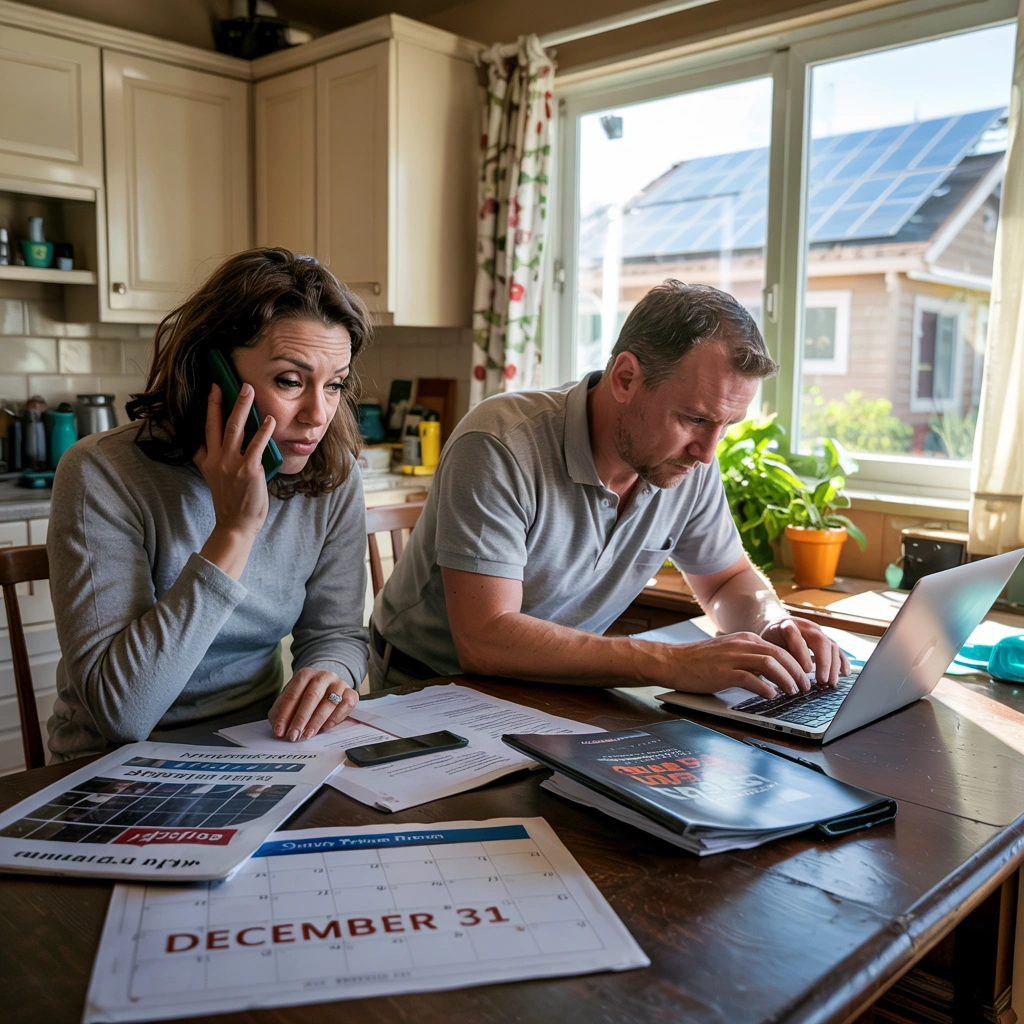
Summary: Nevada homeowners have until December 31, 2025, to lock in the full 30% federal solar tax credit—but getting loan approval could take longer than you think, and waiting could cost you thousands.
Key Takeaways
- The federal solar tax credit drops from 30% to 26% after December 31, 2025, costing Nevada families up to $1,600 on a typical $40,000 solar system
- Solar loan requirements include credit scores of 580+ minimum (720+ for best rates), steady income verification, and debt-to-income ratios below 43%
- Complete loan applications with all documents move through approval in 1-3 weeks, but installation backlogs could push projects past the December 2025 deadline
- Alternative financing options like home equity loans and solar lease programs exist for families who don’t qualify for traditional solar loans
- Starting applications now secures better terms before lending standards tighten as the deadline approaches
Nevada Solar Loans Get Harder After December 2025—Start Now or Lose Thousands
Nevada homeowners face a critical deadline that will directly impact their solar financing options and long-term savings. The federal Residential Clean Energy Credit drops from 30% to 26% on January 1, 2026, representing real money lost for families considering solar installation. On a typical Nevada solar system costing $40,000, this reduction equals $1,600 in lost tax savings.
Solar lending institutions already anticipate increased demand as this deadline approaches. Approval requirements grow stricter, interest rates climb, and processing times extend as more Nevada families compete for financing. The favorable lending conditions available today may not exist in late 2025.
Understanding these market dynamics becomes vital for Nevada residents planning solar installations. The New Nevada Solar Tax Credit Deadline guide provides detailed information on how these changes specifically affect Reno and Las Vegas area homeowners and their financing strategies.
What Changes After 2025 That Cost Nevada Families Real Money
Multiple factors converge to make 2026 significantly more expensive for Nevada solar installations. The federal tax credit reduction represents the most immediate impact, but additional challenges compound the financial strain on families.
Federal Solar Tax Credit Expires December 31, 2025
The federal Residential Clean Energy Credit currently covers 30% of total solar system costs for Nevada homeowners. This includes equipment, installation, permits, and interconnection fees. After December 31, 2025, the credit drops to 26%, then phases down to 22% for property placed in service in 2034.
For Nevada’s average solar system costing approximately $14,364 before incentives, the current 30% credit provides $4,309 in tax savings. The reduced 26% credit in 2026 provides only $3,735, representing a $574 loss on this system size.
Loan Companies May Adjust Standards as Deadline Approaches
Solar financing companies monitor federal incentive schedules closely. As tax credit expiration approaches, lenders typically tighten approval criteria and adjust interest rates upward. This pattern reflects increased risk as borrowers face higher net system costs without full federal support.
Current approval rates for Nevada solar loans remain favorable, with many lenders accepting credit scores as low as 580. These minimum requirements may increase to 620 or higher as 2025 progresses and loan demand intensifies.
Installation Backlogs Could Push Projects Past Deadline
Nevada’s solar installation industry faces capacity constraints during peak demand periods. Licensed contractors book months in advance, and equipment supply chains experience delays during high-volume seasons. Projects starting too late risk completion after the December 31, 2025, deadline.
Weather delays, permit processing times, and utility interconnection requirements add unpredictable timeline extensions. Nevada homeowners must account for these factors when planning loan applications and installation schedules. Homeowners should consider booking solar installations by October 2025 to help ensure tax credit eligibility.
Nevada Solar Loan Requirements That Determine Your Approval
Nevada solar lenders evaluate applications using consistent criteria that borrowers can prepare for in advance. Understanding these requirements helps families position themselves for faster approvals and better terms.
Credit Score Requirements: 580+ Minimum to 720+ for Best Terms
Most Nevada solar financing requires minimum credit scores between 580-650, depending on the lender and loan program. Specialized solar lenders often accept lower scores than traditional banks, but with higher interest rates as compensation for increased risk.
The best solar loan rates go to borrowers with credit scores above 720. These customers typically secure rates between 3-6% APR, compared to 8-12% APR for borrowers with scores below 650. Over a typical 15-year loan term, this rate difference costs thousands in additional interest payments.
Income Documentation and Debt-to-Income Standards
Lenders require proof of steady income sufficient to support monthly solar loan payments. Employed borrowers need recent pay stubs and tax returns. Self-employed applicants must provide two years of tax returns plus current profit and loss statements.
Debt-to-income ratios should remain below 43% including the proposed solar payment. This calculation includes mortgage payments, car loans, credit cards, and all other monthly debt obligations divided by gross monthly income.
Property Documentation and Ownership Verification
Solar loans require clear property ownership verification since systems attach to real estate. Recent mortgage statements provide the strongest documentation, supplemented by property tax records and homeowner’s insurance declarations.
Some lenders require property appraisals to ensure adequate equity for the loan amount. Nevada’s strong real estate market typically supports solar loan requirements, but recent market changes may affect individual situations.
Documents That Speed Up Nevada Solar Loan Processing
Complete documentation packages move through underwriting significantly faster than incomplete submissions. Missing paperwork creates delays that could push installations past critical deadlines.
1. Employment and Income Documentation
Recent pay stubs covering the most recent 30-60 days provide primary income verification. Tax returns from the previous two years show income stability and trends. Bank statements demonstrate consistent deposits and financial management.
Self-employed borrowers need additional documentation, including business licenses, accountant-prepared financial statements, and contracts showing future income prospects. Retirees submit Social Security statements, pension documentation, and retirement account statements.
2. Property Ownership and Insurance Verification
Current mortgage statements show payment history and remaining balance. Property tax assessments confirm ownership and current value. Homeowner’s insurance declarations demonstrate adequate coverage for the property and proposed solar installation.
For properties owned free and clear, property deeds provide ownership verification. Some lenders accept title insurance policies as alternative documentation.
3. Solar Project Specifications and Contracts
Signed installation contracts detail system specifications, costs, and completion timelines. Equipment specifications show panel efficiency, inverter types, and warranty coverage. Energy production estimates justify monthly savings projections used in loan calculations.
Multiple installation quotes help lenders verify reasonable system pricing. Contractor licensing verification ensures professional installation standards.
Strategic Timing for Nevada Solar Applications
Successful solar financing requires coordinating multiple timelines, including loan processing, permit approvals, equipment delivery, and installation scheduling. Strategic planning prevents costly delays.
Working Backward from December 2025 Installation Deadline
Nevada homeowners targeting December 2025 completion should start loan applications by spring 2025 at the latest. This timeline accounts for 2-4 weeks of loan processing, 4-8 weeks of permit and utility approvals, and 2-6 weeks of installation scheduling.
Weather delays, equipment shortages, or permit complications require additional buffer time. Starting applications in early 2025 provides maximum flexibility for unexpected delays while securing current favorable lending terms.
Seasonal Considerations for Processing and Installation
Spring offers ideal conditions for solar applications and installations in Nevada. Moderate temperatures facilitate faster installations, and lenders process requests efficiently after slower winter periods. Equipment availability remains strong before summer demand peaks.
Summer brings high loan application volumes as families target completion before school resumes. Processing times extend, and installation backlogs develop. Fall provides another favorable window with good weather and motivated contractors completing year-end projects.
Common Nevada Solar Loan Rejection Reasons You Can Avoid
Most solar loan rejections stem from preventable issues that careful preparation can address. Understanding common rejection reasons helps borrowers strengthen applications before submission.
Credit Report Errors and Recent Payment Issues
Credit report errors appear frequently and cause automatic rejections when incorrect information suggests a higher risk. Recent late payments or collection accounts trigger additional scrutiny, even with otherwise acceptable credit scores.
Ordering credit reports from all three bureaus 60 days before applying allows time to dispute errors and address recent issues. Credit repair efforts take weeks or months to reflect in scores, requiring advance planning.
Income Inconsistencies Between Documents
Mismatched income information between pay stubs, tax returns, and bank statements raises red flags for lenders. Seasonal income variations or recent job changes require detailed explanations and additional documentation.
Self-employed borrowers face particular challenges when business income fluctuates significantly between tax years. Consistent bank deposits and accountant-prepared statements help demonstrate income stability.
High Debt Ratios That Exceed Lender Limits
Debt-to-income ratios exceeding 43% typically result in automatic rejections regardless of credit scores or income levels. Credit card balances offer the fastest path to improving ratios since minimum payments decrease immediately when balances drop.
Paying off car loans or other installment debts also improves ratios, but requires larger lump sum payments. Some borrowers consider debt consolidation loans to reduce total monthly obligations before applying for solar financing.
Alternative Financing When Traditional Solar Loans Don’t Work
Nevada homeowners who don’t qualify for traditional solar loans have several alternative financing paths. These options often feature different approval criteria or faster processing timelines.
Home Equity Loans and Lines of Credit
Home equity loans often provide lower interest rates than solar-specific financing, with rates typically 2-4% below unsecured solar loans. However, processing times extend 4-8 weeks due to appraisal requirements and additional documentation.
Nevada’s strong real estate market supports substantial home equity for many families. Equity-based loans also qualify for tax deduction benefits that solar loans don’t provide.
Solar Lease and Power Purchase Agreements
Solar leases require minimal upfront costs and lower credit requirements since homeowners don’t own the equipment. Monthly lease payments typically cost less than current utility bills, providing immediate savings without qualification challenges.
Power Purchase Agreements (PPAs) allow solar installation with no upfront costs, charging only for the electricity the system produces. These agreements require minimal credit checks since families buy power rather than equipment.
Nevada Clean Energy Fund Programs
The Nevada Clean Energy Fund’s RE-UP program offers financing benefits for residential properties in participating areas. These programs may have different approval criteria than traditional solar loans and can provide additional support for qualifying homeowners.
Start Your Nevada Solar Loan Application Now While Full Tax Credits Remain
The window for maximum Nevada solar savings closes rapidly as 2025 progresses. Homeowners who act now secure better financing terms, complete installations before incentive reductions, and position themselves ahead of the approaching deadline rush.
Current market conditions favor solar loan applicants with competitive rates, reasonable approval standards, and manageable processing times. These favorable conditions may not persist as demand intensifies and lenders adjust to changing risk profiles.
Nevada families considering solar installation should begin loan applications immediately, gather required documentation, and coordinate with licensed contractors for installation scheduling. Each month of delay increases costs and reduces available options.
The mathematics strongly favor immediate action over waiting. Lost tax credits, higher interest rates, and increased system costs compound quickly, potentially adding thousands to total solar investment expenses. Nevada homeowners benefit most by securing financing now while optimal conditions remain available.
For expert guidance on navigating Nevada’s solar financing options and maximizing available incentives, M&J Trusted Marketing provides detailed solar market analysis and strategic planning services for Nevada homeowners.
Frequently Asked Questions
How Solar Installation Companies Can Leverage This Content
This informative article, “Deadline Checklist: Getting Your Nevada Solar Loan Approved Before 2026” can be adapted and repurposed across multiple marketing formats to help increase website traffic for kitchen remodeling services, build trust with potential clients, and differentiate their services in a competitive market. We help with “Unlock More Solar Leads With Expert Content Repurposing Strategies” by transforming technical content into powerful marketing campaigns across all digital channels, ensuring maximum reach and engagement with potential customers.






